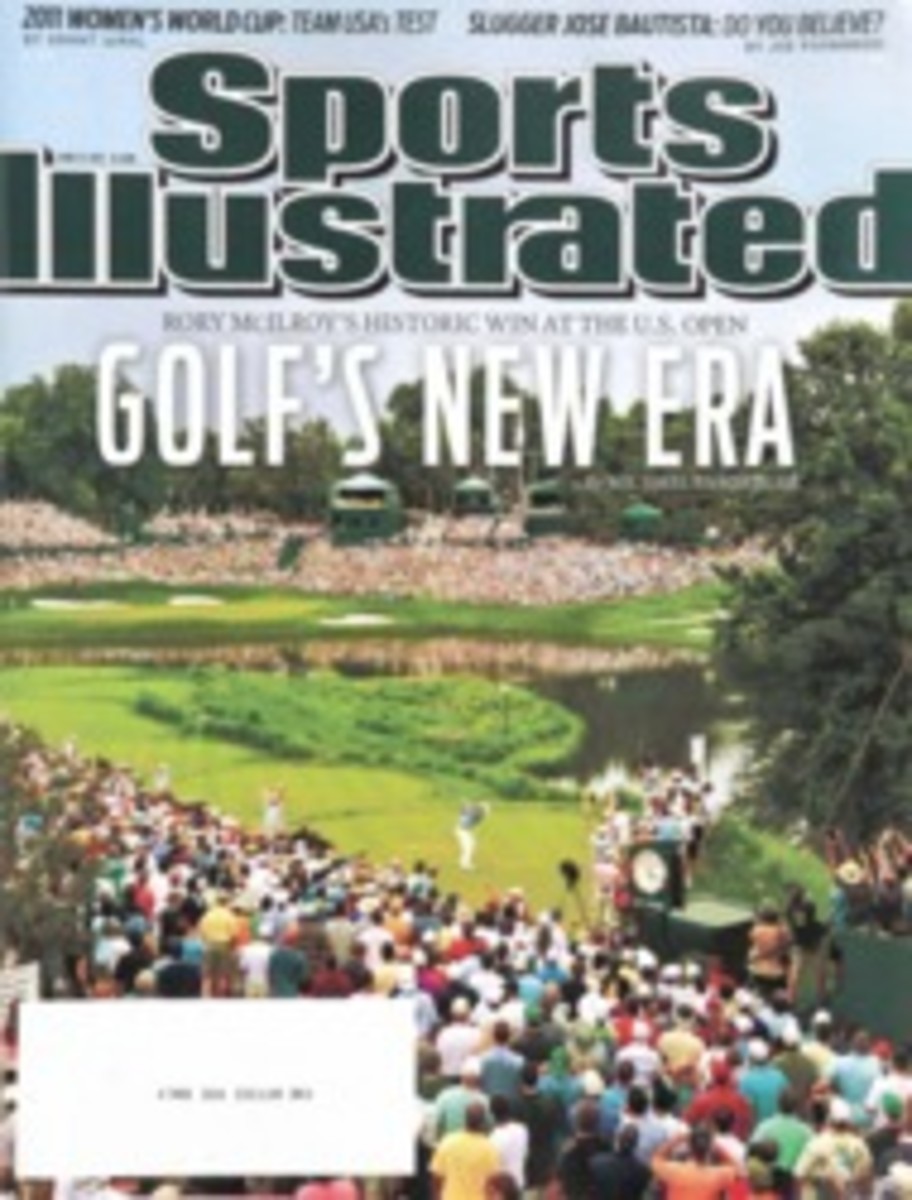
HERE WE GO AGAIN
Meet the new boss, same as the old boss. Well, maybe not exactly the same, but the ascension of Rory McIlroy sure feels like the second coming of Tiger Woods, especially to the guys who have to compete against him for the next 10 or 20 years
Rory McIlroy is such a likable lad that in the wake of his record-smashing performance at the U.S. Open his peers swallowed their usual selfishness and offered nothing but kind words. But behind the forced smiles and polite praise there was an unmistakable wariness.
Throughout the Open no one gushed about McIlroy more than his countryman Graeme McDowell, who at one point declared, "He's the best player I've ever seen." In a quiet moment on Sunday evening McDowell stood in the Congressional Country Club clubhouse nursing his ego and a can of beer wrapped discreetly in a paper napkin.
"It's demoralizing," McDowell said with a sigh. "He can do things to a golf ball that I can't. That almost no one else can. He can fly it 340 down the middle then land a three-iron as soft as a butterfly with blisters. Golf is hard for the rest of us. It's a struggle. He makes the game look so easy, it's a joke."
McDowell, 32, and others didn't quite say it, but it was easy enough to ascertain what two generations of players were thinking: "Great, here we go again."
For more than a decade Tiger Woods's dominance was so oppressive, it stunted the careers of even the most extravagantly talented players. Over the last 18 months—as Woods has been derailed by a tabloid-fueled sex scandal, costly divorce, putting woes, swing changes and the breakdown of his overworked body—there was a sense that the sport had been cracked wide open and that anybody could win on any given week. When Phil Mickelson, 41, took the first post-Uchitel Masters, it gave hope to his fellow aging warriors that they could enjoy triumphant final stages to their careers, adding some of the important trophies that Woods had vacuumed up for so long. Then when McDowell and twentysomethings Louis Oosthuizen, Martin Kaymer and Charl Schwartzel followed with major championship victories, it validated the belief that a big cast of new stars was finally ready to shine.
That's all out the window now. We are going from the Tiger era directly into the Rory era, without passing go or collecting 200 FedEx Cup points. McIlroy's game-changing victory has implications for everyone in the sport, beginning with the champion who inspired him as a wee boy, Woods. The chase to exceed Jack Nicklaus's career total of 18 major championships was supposed to belong exclusively to Tiger, but amazingly, McIlroy is now in the conversation. "What is he, 22 years old?" Padraig Harrington asks, correctly. "If you are going to talk about someone challenging Jack's record, there's your man."
Nicklaus was 22 when he won his first major, the 1962 U.S. Open, and Woods was 21 when he broke through at the '97 Masters, so McIlroy is right on schedule. (And don't forget, it took Woods 28 more months to win his second.) Woods has been sidelined since early May with injuries to his left knee and Achilles; when he's finally healthy enough to resume his climb up Mount Nicklaus, he will have to get past a younger, fitter new champion who carries none of his emotional or societal baggage. And—blasphemy alert—McIlroy has as much game as Tiger, maybe more. Says Luke Donald, "He probably has the most talent I've ever seen for a golfer."
"Can he be the next Tiger?" asks McDowell. "Those are really big shoes to fill. Rory has the talent. He's obviously proved that. But will he have the focus, the single-mindedness of purpose? Ultimately it will come down to how bad he wants it."
But even one of Woods's biggest honks couldn't resist drawing parallels. "Rory's swing looks as good as Tiger's did when he was in his prime, when he was swinging his best," says Steve Stricker. That was 11 years and two swing overhauls ago. And while Woods continues to struggle to master his new action, McIlroy's poetic swing has remained basically the same since he was 16, and he's smart enough not to start tinkering.
Things aren't looking any better for the other headliner of the epoch that ended last week. Mickelson had the misfortune of being paired with McIlroy for the first two rounds of the Open, and at times it appeared they were playing a different course, with Phil flailing away from uncharted corners of Congressional while McIlroy la-di-da'd his way down the sprinkler line. Since his record fifth runner-up finish at last year's U.S. Open—which was also when he was first stricken with psoriatic arthritis—Mickelson has been a nonfactor in the majors. After a week in which he ranked 47th of 72 by hitting only 63% of the rain-softened greens in regulation—Rory was No. 1 with an Open record 86%—a befuddled Mickelson was asked what's missing in his game. "I'm not sure yet if I have a great answer for you," he said.
The third wheel in Rory's Thursday-Friday pairing was Dustin Johnson, 27, who was simply run over by McIlroy, trailing by 15 strokes after 36 holes. Among the game's young players only the überathletic Johnson has been thought to have as much upside as McIlroy. But for Johnson and all the other would-be young bucks, potential is now no longer enough. It's time to produce, and they know it. "There's definitely pressure to keep up," says Kaymer, 26. "The golf Rory played here was unbelievable. He has set a new standard for us. It's inspiring, for sure."
Not for everybody. Donald, who's ascension to No. 1 in the World Ranking without the benefit of a major championship victory had highlighted the sport's recent parity, was asked on Sunday if he was inspired or demoralized. "Both," Donald, 33, said with a smile.
As spectacularly as McIlroy played, no one was really surprised by his outburst. "This has been a long time coming," says Paul Casey, who had been awed by a 17-year-old McIlroy when the two met during a casual game years ago. "He had more shots than I did!" says Casey. "He simply attacked the golf course." In the last 11 months McIlroy has brought his pedal-to-the-metal game to the majors, shooting a 63 in the British Open at St. Andrews, a 65 at Augusta National and 16 under par in the U.S. freaking Open. Now that he's learned to close, "Rory has to be the favorite at every major for a good long while," says Charley Hoffman. "He's earned that respect."
McIlroy's riveting play—and the charisma and likability he projected—took the Tour back to a simpler time when one player drove the narrative for an entire sport. Does golf need another dominant player to emerge? "Yes and no," says Hoffman. "If you've been watching the tournaments this year, there have been so many exciting finishes. It's been pretty cool that there hasn't really been a favorite from week to week. A lot of new guys have had a shot. But for casual fans I think they need a dominant player to focus on. They need to know what the story line is."
McIlroy's victory will also further complicate the game's geopolitics. He famously skipped this year's Players, a protest of sorts against the PGA Tour's membership requirements. On Sunday night McIlroy's hegemonic agent, Chubby Chandler, did his usual saber-rattling, saying his client would like to become a Tour member but only if the requirement to play a minimum of 15 tournaments is relaxed. Given the sudden demand to see the young master play more Stateside, PGA Tour commissioner Tim Finchem will be under pressure to find a resolution that brings McIlroy into the fold.
Only time will tell if this U.S. Open is the high point of a good-but-not-great career—don't forget, Lee Janzen once shot 272 in a U.S. Open, only four strokes off McIlroy's pace—but the early indicators are promising. Says Casey, "He already has the bit that usually takes a long time: maturity. I don't know if that's something you're born with or it's simply really good parenting, but he has a tremendous attitude and perspective."
Even those preaching caution can't help but fret about what McIlroy's ascension means for the competition. "It's only his third win," says Donald. "He's not quite dominating the game yet, but he's going to be a tough force to reckon with."
Sorry, Luke, but he already is.
Now on GOLF.com
Who's hot and who's not? Check out Alan Shipnuck's Hot List every week at GOLF.com
IT GAVE HOPE TO AGING WARRIORS THAT THEY COULD ENJOY TRIUMPHANT FINAL STAGES TO THEIR CAREERS.
"THERE'S DEFINITELY PRESSURE TO KEEP UP," SAYS KAYMER. "THE GOLF RORY PLAYED WAS UNBELIEVABLE."
Sports Illustrated
BONUS SECTION | GOLF.COM
PHOTO
Photograph by FRED VUICH
SEEING RED Just as an age of blessed parity appeared to be dawning, McIlroy came along with a performance so dominating that his fellow pros are fearing for their career arcs.
TWO PHOTOS
AL TIELEMANS
SUNSET SWING After picking Woods's scraps for years, fortysomething pros like Stricker (left) and Mickelson were finally positioned to benefit.
TWO PHOTOS
SIMON BRUTY
LONG HAUL Jason Day (above) and Johnson are two of the game's bright young lights, but they will have to dodge McIlroy's shadow for years to come.

